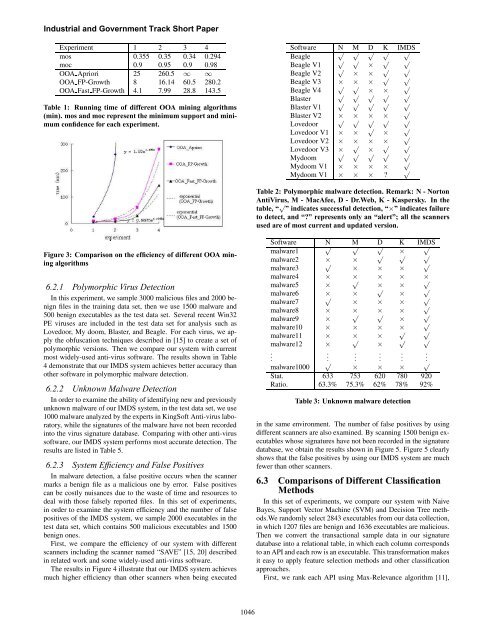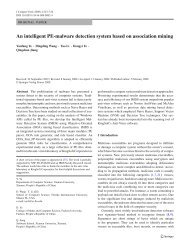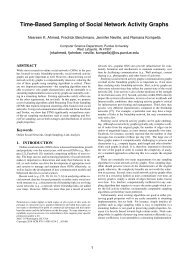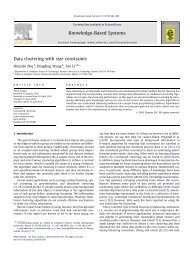IMDS: Intelligent Malware Detection System - Florida International ...
IMDS: Intelligent Malware Detection System - Florida International ...
IMDS: Intelligent Malware Detection System - Florida International ...
You also want an ePaper? Increase the reach of your titles
YUMPU automatically turns print PDFs into web optimized ePapers that Google loves.
Industrial and Government Track Short Paper<br />
Experiment 1 2 3 4<br />
mos 0.355 0.35 0.34 0.294<br />
moc 0.9 0.95 0.9 0.98<br />
OOA Apriori 25 260.5 ∞ ∞<br />
OOA FP-Growth 8 16.14 60.5 280.2<br />
OOA Fast FP-Growth 4.1 7.99 28.8 143.5<br />
Table 1: Running time of different OOA mining algorithms<br />
(min). mos and moc represent the minimum support and minimum<br />
confidence for each experiment.<br />
Software N M D K <strong>IMDS</strong><br />
√ √ √ √ √<br />
Beagle<br />
√ √ √ √<br />
Beagle V1<br />
√ ×<br />
√ √<br />
Beagle V2 × ×<br />
Beagle V3 × × × √ √<br />
√ √ √<br />
Beagle V4<br />
√ √ √ ×<br />
√ ×<br />
√<br />
Blaster<br />
√ √ √ √ √<br />
Blaster V1<br />
√<br />
Blaster V2<br />
√<br />
×<br />
√<br />
×<br />
√<br />
×<br />
√<br />
×<br />
√<br />
Lovedoor<br />
Lovedoor V1 × × √ √<br />
×<br />
√<br />
Lovedoor V2 × × × ×<br />
Lovedoor V3 × √ × √ √<br />
√ √ √ √ √<br />
Mydoom<br />
√<br />
Mydoom V1 × × × ×<br />
√<br />
Mydoom V1 × × × ?<br />
Table 2: Polymorphic malware detection. Remark: N - Norton<br />
AntiVirus, M - MacAfee, D - Dr.Web, K - Kaspersky. In the<br />
table, “ √ ” indicates successful detection, “×” indicates failure<br />
to detect, and “?” represents only an “alert”; all the scanners<br />
used are of most current and updated version.<br />
Figure 3: Comparison on the efficiency of different OOA mining<br />
algorithms<br />
6.2.1 Polymorphic Virus <strong>Detection</strong><br />
In this experiment, we sample 3000 malicious files and 2000 benign<br />
files in the training data set, then we use 1500 malware and<br />
500 benign executables as the test data set. Several recent Win32<br />
PE viruses are included in the test data set for analysis such as<br />
Lovedoor, My doom, Blaster, and Beagle. For each virus, we apply<br />
the obfuscation techniques described in [15] to create a set of<br />
polymorphic versions. Then we compare our system with current<br />
most widely-used anti-virus software. The results shown in Table<br />
4 demonstrate that our <strong>IMDS</strong> system achieves better accuracy than<br />
other software in polymorphic malware detection.<br />
6.2.2 Unknown <strong>Malware</strong> <strong>Detection</strong><br />
In order to examine the ability of identifying new and previously<br />
unknown malware of our <strong>IMDS</strong> system, in the test data set, we use<br />
1000 malware analyzed by the experts in KingSoft Anti-virus laboratory,<br />
while the signatures of the malware have not been recorded<br />
into the virus signature database. Comparing with other anti-virus<br />
software, our <strong>IMDS</strong> system performs most accurate detection. The<br />
results are listed in Table 5.<br />
6.2.3 <strong>System</strong> Efficiency and False Positives<br />
In malware detection, a false positive occurs when the scanner<br />
marks a benign file as a malicious one by error. False positives<br />
can be costly nuisances due to the waste of time and resources to<br />
deal with those falsely reported files. In this set of experiments,<br />
in order to examine the system efficiency and the number of false<br />
positives of the <strong>IMDS</strong> system, we sample 2000 executables in the<br />
test data set, which contains 500 malicious executables and 1500<br />
benign ones.<br />
First, we compare the efficiency of our system with different<br />
scanners including the scanner named “SAVE” [15, 20] described<br />
in related work and some widely-used anti-virus software.<br />
The results in Figure 4 illustrate that our <strong>IMDS</strong> system achieves<br />
much higher efficiency than other scanners when being executed<br />
Software N M D K <strong>IMDS</strong><br />
√ √ √<br />
√<br />
malware1<br />
√ √<br />
×<br />
√<br />
malware2<br />
√<br />
× ×<br />
√<br />
malware3<br />
× × ×<br />
malware4 ×<br />
√<br />
× × ×<br />
√<br />
×<br />
malware5 ×<br />
√<br />
× ×<br />
√<br />
malware6<br />
√<br />
× ×<br />
×<br />
√<br />
malware7<br />
× × ×<br />
√<br />
malware8 ×<br />
√<br />
×<br />
√<br />
× ×<br />
√<br />
malware9 ×<br />
×<br />
√<br />
malware10 × × ×<br />
√<br />
×<br />
√<br />
malware11 ×<br />
√<br />
× ×<br />
√ √<br />
malware12 ×<br />
×<br />
.<br />
.<br />
.<br />
.<br />
.<br />
√<br />
√<br />
.<br />
malware1000<br />
× × ×<br />
Stat. 633 753 620 780 920<br />
Ratio. 63.3% 75.3% 62% 78% 92%<br />
Table 3: Unknown malware detection<br />
in the same environment. The number of false positives by using<br />
different scanners are also examined. By scanning 1500 benign executables<br />
whose signatures have not been recorded in the signature<br />
database, we obtain the results shown in Figure 5. Figure 5 clearly<br />
shows that the false positives by using our <strong>IMDS</strong> system are much<br />
fewer than other scanners.<br />
6.3 Comparisons of Different Classification<br />
Methods<br />
In this set of experiments, we compare our system with Naive<br />
Bayes, Support Vector Machine (SVM) and Decision Tree methods.We<br />
randomly select 2843 executables from our data collection,<br />
in which 1207 files are benign and 1636 executables are malicious.<br />
Then we convert the transactional sample data in our signature<br />
database into a relational table, in which each column corresponds<br />
to an API and each row is an executable. This transformation makes<br />
it easy to apply feature selection methods and other classification<br />
approaches.<br />
First, we rank each API using Max-Relevance algorithm [11],<br />
1046









